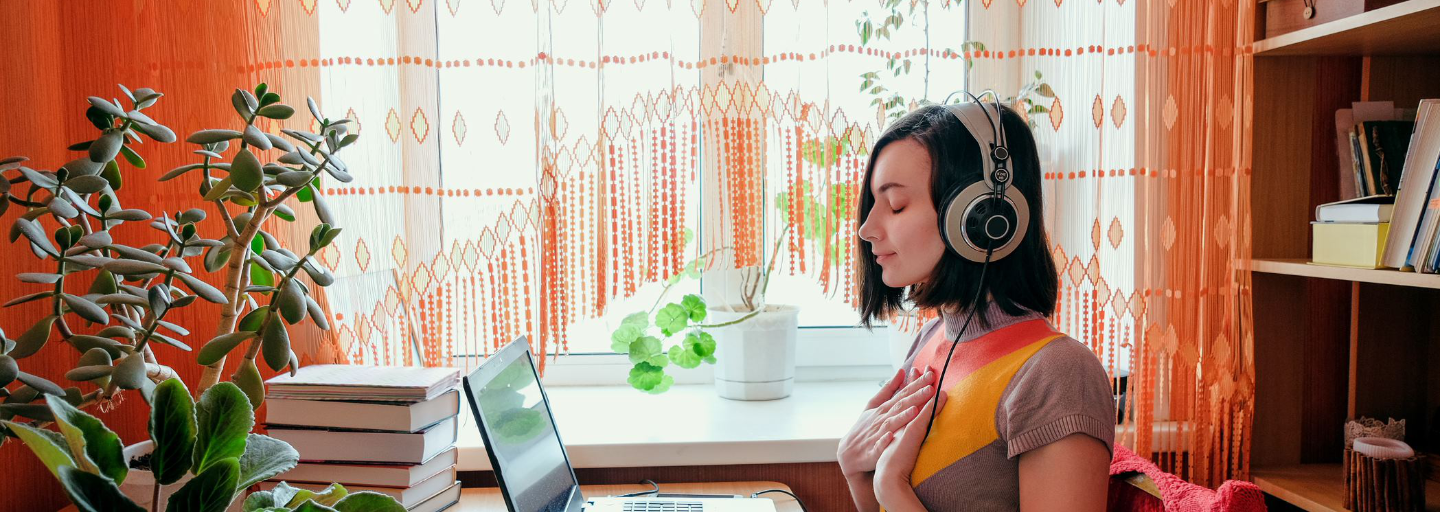Self-help program
1. Breathing and relaxation
Background information about abdominal breathing
We use several breathing muscles, the most effective of which is the diaphragm, located in your abdomen.
Abdominal breathing often decreases during anxiety or some other stressful situation. In this case, breathing occurs more in the upper part of the ribcage and becomes rapid and shallow. As a result, the abdomen becomes tense and our anxiety increases. This usually happens without noticing.
Abdominal breathing relaxes
During abdominal breathing, the abdominal walls rise when we breath in and fall when we breath out. This completely fills the lungs with air.
When breathing is shallow and difficult, the movements of the abdomen are too small and may cause shortness of breath.
Activating abdominal breathing and deepening and calming the breathing rhythm usually increases the feeling of calmness. This can happen almost instantly. With the right breathing technique, other muscle groups also relax.
A break between inhaling and exhaling helps to prevent hyperventilation, as does making sure you exhale all the air you breathed in.
Breathing anchors you to the moment
Breathing often serves as the anchor in relaxation and attention exercises. If you have difficulty concentrating or you feel frustrated, focus on your breathing.
Abdominal breathing decreases anxiety
Activating abdominal breathing is useful when you experience a feeling of anxiety.
When you feel anxiety, you can also consciously go through different muscle groups: relax the neck and shoulder muscles, jaw muscles and other muscle groups.
Watch the video for tips on how to calm down your breath
Leading psychologist Jan-Henry Stenberg shows in the following video (1:57) how to relieve anxiety with the help of breathing.
First, you will hear why shallow breathing often activates and maintains anxiety. One minute into the video, you get instructions for calming abdominal breathing.
Abdominal breathing (0:31)
Goal
You will learn to observe your breathing and activate calm abdominal breathing. This alone can be enough to relieve the feeling of anxiety.
Instructions
- Take a comfortable position but don't cross your legs.
- Place one hand on your chest and the other on your stomach.
- Slowly breath in and out.
- Try to make sure that only the hand resting on the stomach moves during breathing. The chest should stay in place.
- Focus on your breathing, and continue breathing this way for a while.
Focus on counting the breaths in 1, out 1, in 2, out 2 and so on. Focus on counting to ten without speeding up your breathing.
Whenever your mind starts wandering, bring your attention gently back to your breathing. If you lose focus, start again from 2 and proceed calmly. There's no hurry anywhere right now.
Practice abdominal breathing before hand with the help of the video (subtitles in English). Do the exercise when you feel anxious and the anxiety interferes with your everyday activities.
We recommend doing the exercise every day, and sometimes even more than once a day.
- It's important to do the exercise regularly for at least 2-3 weeks.
- Practising regularly gives more lasting results.
By repeating the exercise, you learn to activate abdominal breathing everytime you feel anxiety symptoms.
Relaxation exercises
There are different types of relaxation exercises. You can read more about the exercises below and try which ones are most suitable for you. You can return to the exercises in suitable situations.
Relaxation Exercise (6:23)
Goal
You will learn to relax muscle tension with the help of thoughts and mental images.
Instructions
You consciously practice to focus on different muscle groups and to relax them with the help of mental images.
We recommend doing the exercise every day, and sometimes even more than once a day.
- It's important to do the exercise regularly for at least 2-3 weeks.
- Practising regularly gives more lasting results.
By repeating the exercise, you learn to relax your muscles everytime you feel anxiety symptoms.
You can read or listen to the excercise.
Progressive Muscle Relaxation (7:12)
Goal
You will learn to relax your muscles using the tension-relaxation technique.
Instructions
You practice focusing on your body and breathing. You go through different muscle groups by first tensing them and then relaxing them.
Choose a quiet place where you can do the exercise sitting down.
We recommend doing the exercise every day, and sometimes even more than once a day.
- It's important to do the exercise regularly for at least 2-3 weeks.
- Practising regularly gives more lasting results.
By repeating the exercise, you learn to relax your muscles everytime you feel anxiety symptoms.
You can read or listen to the excercise.
Progressive Muscle Relaxation lying down (12:59)
Goal
You will learn to relax your muscles using the tension-relaxation technique.
Instructions
You practice focusing on your body and breathing. You go through different muscle groups by first tensing them and then relaxing them.
Find a quiet place where you can do the exercise lying down, on the floor or on a bed.
The same type of relaxation technique is used here, as in the previous exercise, but the exercise is done lying down instead of sitting. This is also a longer exercise. You can choose the suitable exercise depending on the situation.
We recommend doing the exercise regularly every day, and sometimes even more than once a day.
- It's important to do the exercise regularly for at least 2-3 weeks.
- Practising regularly gives more lasting results.
By repeating the exercise, you learn to relax your muscles everytime you feel anxiety symptoms.
You can do the excercise with the help of the video (subtitles in English).
